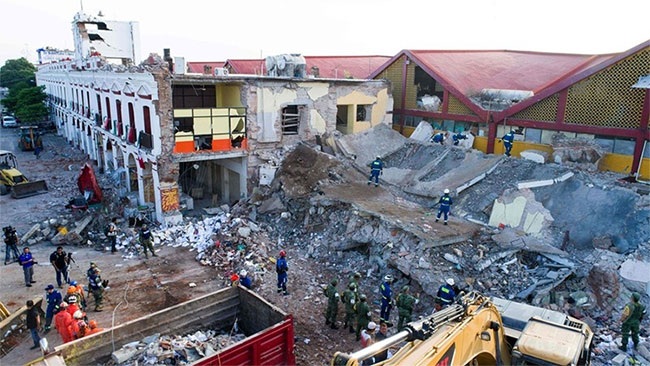Mexico earthquake 'torn' a tectonic plate
The 8.2-magnitude earthquake in southern Mexico was so strong in September 2017 that the tectonic plate below the area split in half.
The new study, published in the journal Nature Geoscience, concludes the impact of the quake making Cocos tectonic plates removed in seconds and releasing maximum energy, Fox News reported on October 25. "We found that the fracture re-activates the curvature fracture and spreads further down the brittle-plastic transition zone of the Cocos array, including areas with expected temperatures above 1,000 ° C , " the authors group. study said.

Crumbling houses due to the 8.2-magnitude earthquake shook southern Mexico.(Photo: AFP).
Lead researcher Diego Melgar, an Earth scientist at the University of Oregon, said he and his colleagues haven't yet figured out how to explain this process."We cannot explain the cause of the process yet. We can only confirm it contrary to previous models and need to conduct further research to understand , " Melgar said.
Such a large and powerful earthquake happened in the past. In 1933, the same earthquake in Sanriku, Japan, caused a tsunami of 29 meters high, killing 1,522 people and destroying more than 7,000 houses. Another earthquake occurred in 1939 beneath the Chilean town of Chillán, killing at least 30,000 people. Due to the proximity of the sea, the magnitude of the damage caused by earthquakes is greater due to the risk of tsunamis.
The 8.2-degree earthquake in Tehuantepec, Mexico last year cracked Cocos, a relatively young tectonic plate dating back 25 million years and producing a two-meter high tsunami."This submerged glass is still very young and warm, geologically. It should not be broken , " Melgar said. For comparison, the subduction zone in Japan dates back to 130 million years.
Tectonic plates often move around the Earth's surface and crash into each other, forming new mountains or sliding down each other, creating a submerged suction zone. Chronology and temperature of submerged zone are diverse, and temperature becomes lower as they move outward. Stress-related earthquakes are primarily the result of long-standing tectonic plates with cooler temperatures (about 650 degrees Celsius). This makes the impact from the earthquake in Tehuantepec difficult to understand.
Melgar's group raised a number of hypotheses. They argue that seawater infiltrating Cocos tectonic plates can accelerate the process of heat reduction, making it easier to crack before earthquakes that are common in cold and older places. If this is the case, areas such as southern Guatemala and the US West Coast are easily affected by earthquakes in the compressive zone.
- The bottom of North America plate tectonics is
- Earthquakes in China are very unusual
- Found tectonic plate
- The reason for Mexico's strong earthquake
- Find the culprit causing earthquakes in Iran
- Russian scientists touch the center of the Earth
- New findings about predicting earthquakes can save millions of lives
- Taiwan is shaken by an earthquake of 6 degrees
- Earthquake magnifies 6.2 Richter off Mexico
- Houses crumbling after the earthquake in Taiwan
- Detecting strange tectonic plates at a depth of 660km in the South Pacific
- An earthquake occurred in Vanuatu, Mexico and China
 Is the magnetic North Pole shift dangerous to humanity?
Is the magnetic North Pole shift dangerous to humanity? Washington legalizes the recycling of human bodies into fertilizer
Washington legalizes the recycling of human bodies into fertilizer Lightning stone - the mysterious guest
Lightning stone - the mysterious guest Stunned by the mysterious sunset, strange appearance
Stunned by the mysterious sunset, strange appearance